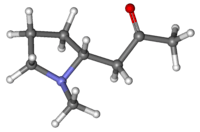Hygrine
From Wikipedia, the free encyclopedia
| Hygrine | |
|---|---|
 | |
 | |
| IUPAC name (R)-1-(1-Methylpyrrolidin-2-yl)-propan-2-one | |
| Identifiers | |
| CAS number | 496-49-1 |
| PubChem | 440933 |
| ChemSpider | 389762 |
| KEGG | C06179 |
| ChEBI | CHEBI:46750 |
| Jmol-3D images | {{#if:CC(=O)C[C@H]1CCCN1C|Image 1 |
| |
| |
| Properties | |
| Molecular formula | C8H15NO |
| Molar mass | 141.21 g/mol |
| Boiling point | 193–195 °C |
| Except where noted otherwise, data are given for materials in their standard state (at 25 °C (77 °F), 100 kPa) | |
| Infobox references | |
Hygrine is a pyrrolidine alkaloid, found mainly in coca leaves (0.2%). It was first isolated by Carl Liebermann in 1889 (along with a related compound cuscohygrine) as an alkaloid accompanying cocaine in coca. Hygrine is extracted as a thick yellow oil, having a pungent taste and odor.
See also
References
- Dr. Ame Pictet (1904). The Vegetable Alkaloids. With particular reference to their chemical constitution. London: Chapman & Hall.
- "Hygrine". Webster's Revised Unabridged Dictionary (? ed.). 1913.
- "USDA, ARS, National Genetic Resources Program. Phytochemical and Ethnobotanical Databases.[Online Database] National Germplasm Resources Laboratory, Beltsville, Maryland.". Retrieved July 15, 2005.
This article is issued from Wikipedia. The text is available under the Creative Commons Attribution/Share Alike; additional terms may apply for the media files.